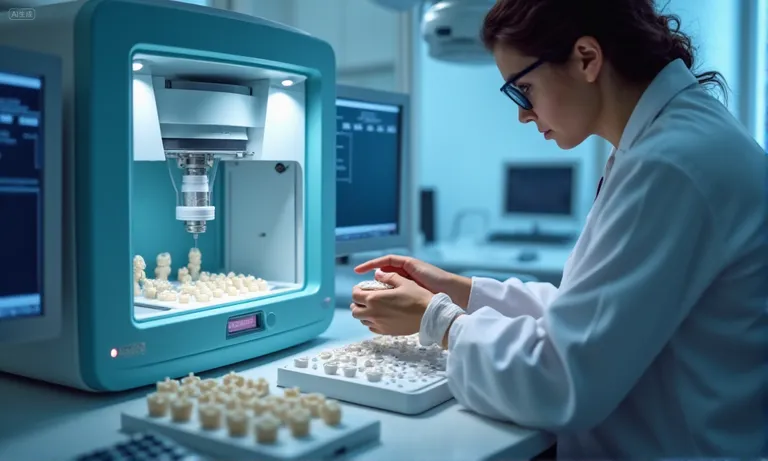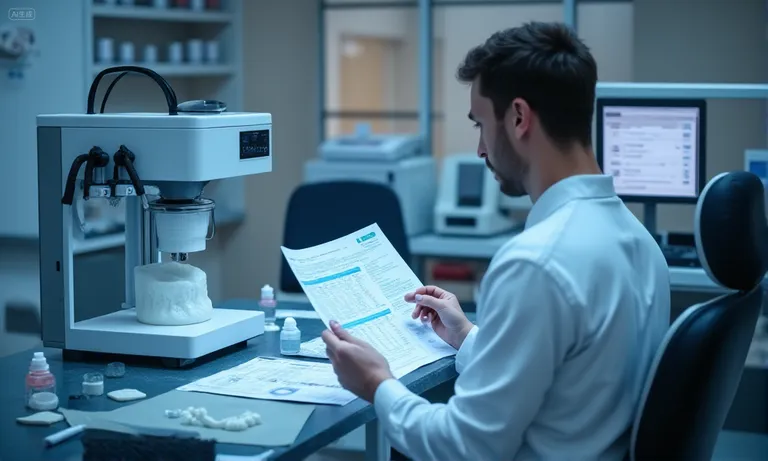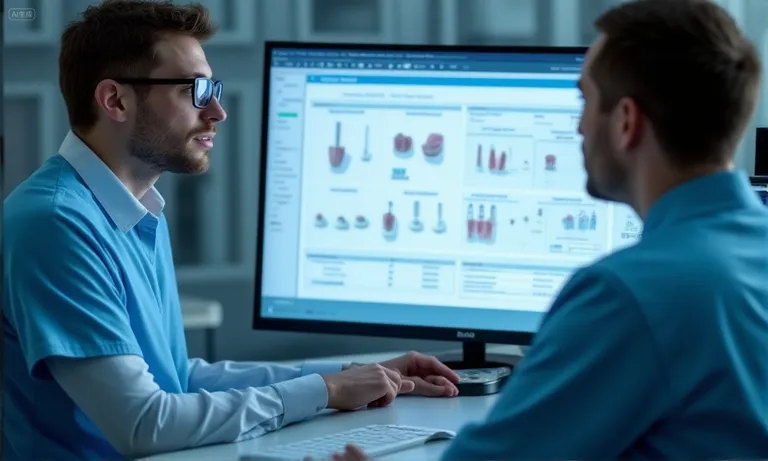3D printing is reshaping dental implant lab workflows by reducing costs and dramatically improving efficiency. From digital scan to final restoration, additive manufacturing eliminates waste, reduces reliance on manual processes, and shortens turnaround times. For buyers, this shift translates into predictable savings and more scalable production.
Key considerations include:
- Cost reduction – Automation lowers labor costs, additive processes minimize material waste, and reduced reliance on external labs cuts operational expenses.
- Efficiency gains – Faster turnaround, in-house production, and fewer adjustments create a streamlined, reliable workflow.
- Strategic value – Expanded treatment options, access to advanced technology, and increased productivity provide long-term ROI for procurement teams.
- Buyer evaluation – Partnering with 3D-printing-enabled labs requires verifying QA standards, technical capacity, and service scope to ensure consistent quality.
For procurement teams, the value of 3D printing goes beyond short-term savings. By choosing labs that combine digital expertise with scalable production, buyers can secure both lower costs and higher efficiency—turning technology adoption into a sustainable competitive advantage in dental implant restorations.
Why Is 3D Printing Becoming Essential in Dental Implant Labs?
3D printing is becoming essential in dental implant labs because it enables faster turnaround, greater customization, and scalable workflows that traditional methods cannot match. The shift is not only about adopting new technology but about meeting clinics’ rising expectations for precision, speed, and flexibility in restorative solutions. This makes additive manufacturing more than a trend—it is becoming a baseline capability for modern dental labs.

Dental-lab-3D-printing-implant-workflow
How is 3D printing different from traditional milling or casting?
3D printing differs from milling and casting because it builds restorations layer by layer directly from digital designs, reducing the need for manual intervention. Unlike milling, which subtracts material and generates waste, additive methods optimize material use. Compared with casting, the digital-to-print workflow shortens production time and removes dependency on physical molds.
- Milling = subtractive, higher waste, limited shapes
- Casting = multiple manual steps, longer cycles
- Printing = additive, efficient, highly customizable
What expanded treatment options come with customized restorations?
3D printing opens possibilities for patient-specific implant guides, provisional restorations, and complex geometries that are difficult to achieve with traditional methods. Customization allows clinicians to offer more treatment plans, from full-arch solutions to guided surgeries, while labs can deliver consistent quality at scale. For example, an overseas dental lab using 3D printing can provide a DSO with both single-unit crowns and full-arch surgical guides in the same production workflow.
How does 3D printing increase productivity and scalability for larger case volumes?
Automation enables labs to handle larger case volumes without proportional increases in labor or turnaround time. Multiple restorations can be produced in a single print run, allowing small labs to compete with larger facilities and helping DSOs achieve consistent results across multiple clinics. A recent Journal of Prosthodontics study highlights how 3D printing supports consistent case outcomes, particularly when scaling up implant workflows.
By integrating 3D printing, dental labs demonstrate their ability to align with modern clinical demands. As an overseas dental lab collaborating with clinics and distributors, Raytops has seen that the labs adopting additive manufacturing are increasingly perceived as reliable long-term partners rather than simply production vendors.
How Does 3D Printing Reduce Costs for Implant Restorations?
3D printing reduces costs in implant restorations by lowering labor expenses, minimizing material waste, cutting reliance on external subcontracting, and reducing costly rework. Each of these factors directly impacts a lab’s bottom line, making additive manufacturing one of the most cost-effective upgrades for implant workflows.

Dental-lab-3D-printing-cost-reduction
How does automation lower labor costs in implant workflows?
Automation eliminates repetitive manual steps such as wax-ups, mold creation, and detailed hand adjustments. This means fewer technicians are required to manage the same number of cases.
- Manual wax-ups can take hours per restoration.
- Automated printing allows simultaneous batch production.
- Staff can be reassigned to high-value tasks like QA or client communication.
How does additive manufacturing minimize material waste?
Traditional milling removes material from a block, producing significant waste. Casting involves unused metal and investment material. 3D printing, however, adds material only where needed.
| Method | Material Use | Waste Level | Typical Efficiency |
|---|---|---|---|
| Milling | Subtractive | High | ~40–60% material lost |
| Casting | Mold-based | Medium | ~20–30% wasted |
| 3D Printing | Additive | Low | >90% efficiency |
This efficiency not only saves resin or metal powders but also reduces disposal costs, making workflows more sustainable.
How does in-house 3D printing reduce reliance on external labs?
When labs send out complex implant guides or provisional parts to external partners, they face shipping fees, extra turnaround days, and hidden markup costs. By printing these restorations in-house, labs cut outsourcing costs and keep tighter control over scheduling. For DSOs managing multiple clinics, in-house additive manufacturing provides a predictable supply chain and reduces dependence on third-party vendors.
How do fewer errors and adjustments reduce rework costs?
Fewer errors mean fewer remakes—a major hidden cost in implant workflows. With 3D printing, digital accuracy reduces fit issues, which in turn lowers the frequency of chairside adjustments.
- Fewer misfits reduce remake cycles.
- Reduced chairside adjustments mean less clinician time wasted.
- Consistent output ensures long-term trust and repeat orders.
By consolidating these cost savings, labs achieve a measurable ROI. An overseas dental lab adopting additive workflows often sees savings not just in unit costs but in reduced operational friction, making them more competitive in global collaborations.
What Workflow Efficiencies Come from 3D Printing?
3D printing enhances workflow efficiency in dental implant labs by shortening turnaround times, streamlining in-house production, reducing manual steps, and minimizing costly adjustments through precision. These gains allow labs to respond faster to clinics while scaling case handling without proportionally increasing resources.

Dental-lab-digital-workflow-efficiency
How do direct digital-to-print workflows speed up turnaround time?
By eliminating multiple analog steps, direct digital-to-print workflows cut case cycles significantly.
- Scans are imported directly into CAD software.
- Designs are transferred to the printer without intermediate casting or milling stages.
- Turnaround moves from days to hours, depending on case complexity.
This allows labs to deliver surgical guides or provisional restorations within the same week, a speed difficult to achieve with traditional methods.
How does in-house production streamline case handling?
In-house production ensures that cases do not leave the lab, removing delays caused by shipping or subcontracting. With 3D printing, labs maintain full visibility across design, production, and quality checks. A DSO managing multiple practices benefits from this centralization because implant cases can be prioritized internally, ensuring consistent service levels. For clinics, this translates into predictable timelines and fewer disruptions in patient scheduling.
How does automation reduce manual labor and errors?
Automation replaces repetitive hand adjustments with software-driven precision.
| Workflow Step | Traditional Process | With 3D Printing |
|---|---|---|
| Wax-ups | Manual sculpting | CAD-based automation |
| Mold creation | Investment casting | Digital slicing |
| Fit adjustments | Frequent remakes | Reduced by precision printing |
Automation not only saves time but also reduces variability, ensuring a more predictable outcome across cases.
How does higher precision eliminate costly adjustments?
High-resolution 3D printing produces restorations that fit more accurately, minimizing chairside adjustments and remakes.
- Accurate margins reduce misfits.
- Stable occlusion lowers adjustment time.
- Consistent tolerances improve clinician satisfaction.
- Fewer remakes save both material and labor costs.
Labs leveraging precision printing are perceived as reliable partners. As a global dental lab collaborating with overseas clinics, Raytops has found that higher precision in printed guides consistently strengthens long-term trust with clinicians and procurement teams.
Real-World Case Evidence of 3D Printing Benefits in Implant Labs
The benefits of 3D printing are not theoretical—they are consistently proven in real-world implant workflows. From guided surgeries to full-arch restorations, dental labs report measurable improvements in turnaround, remake rates, and return on investment when adopting additive manufacturing.
Real-world implant cases using 3D printed guides and restorations
A mid-sized independent clinic in Brisbane faced delays when relying on outsourced surgical guides. After shifting to a partner lab using 3D printing, their implant placement workflow shortened by nearly a week. The lab provided both provisional crowns and surgical guides in one delivery, reducing the clinic’s reliance on multiple vendors. This type of collaboration shows how labs applying 3D printing can adapt quickly to clinical needs.
Documented reduction in delivery time and remake rates
Labs that adopt 3D printing often report tangible performance improvements:
- Turnaround time reduced from 10–14 days to 4–6 days for implant guides.
- Remake rates drop by up to 30% compared with traditionally milled cases.
- Provisional restorations can be adjusted digitally before printing, reducing errors at the chairside.
These results are consistent with published findings in the Journal of Prosthetic Dentistry, showing that additive manufacturing not only saves time but also improves clinical accuracy.
How do labs measure ROI from adopting 3D printing technology?
Labs typically evaluate ROI by comparing operational savings with equipment investment.
| ROI Dimension | Traditional Workflow | With 3D Printing | Value to Labs |
|---|---|---|---|
| Equipment investment | Low upfront | Moderate upfront | Long-term savings |
| Material waste | High | Low | Direct cost reduction |
| Labor requirements | High (manual steps) | Lower (automated) | Reassign staff to high-value tasks |
| Remake rates | 8–12% | 3–6% | Fewer reworks and adjustments |
| Turnaround time | 10–14 days | 4–6 days | Higher client satisfaction |
ROI is not only measured in monetary savings but also in strengthened client trust. As an overseas dental lab, Raytops has seen how consistent on-time delivery and reduced remakes build confidence with DSOs and distributors, supporting long-term collaboration.
What Should Buyers Consider Before Partnering with a 3D Printing-Enabled Lab?
Selecting a lab with 3D printing capability is not just about access to technology—it is about ensuring quality, reliability, and long-term partnership value. Buyers should evaluate certifications, expertise, service scope, and partnership fit before committing to collaboration.

Verifying certifications, material validation, and QA standards
Before partnering, buyers should confirm that the lab complies with international certifications and material validation processes.
- ISO certifications for quality management and safety.
- CE or FDA clearance for specific materials and devices.
- Documented QA protocols, including fit testing and material traceability.
These standards ensure that restorations are safe, durable, and legally compliant in target markets.
How can buyers evaluate a lab’s 3D printing expertise and capacity?
Labs differ widely in their ability to deliver reliable outcomes. Buyers should assess expertise with a structured approach:
- Review sample cases and ask for documented outcomes.
- Evaluate the range of printers, resins, or metal systems used.
- Assess staffing skills—are technicians trained in CAD/CAM and 3D workflows?
- Confirm whether the lab can handle both small-batch and high-volume production.
Understanding the scope of services and production scalability
A capable lab should not only provide printed guides but also integrate services like digital design, provisional restorations, and post-processing. Service scope indicates whether the lab can adapt to evolving client needs. For DSOs, scalability is critical: the lab must handle larger case volumes without sacrificing turnaround or quality. In practice, global dental labs offering comprehensive workflows often become strategic partners rather than transactional vendors.
Balancing short-term cost savings with long-term partnership value
While price is important, the cheapest option is rarely the best long-term fit.
| Factor | Short-Term View | Long-Term Partnership Value |
|---|---|---|
| Unit price | Lowest possible | Transparent pricing, stable supply |
| Service quality | Basic delivery | Consistent QA, low remake rate |
| Communication | Transactional | Proactive collaboration |
| Scalability | Limited | Growth capacity with DSOs or distributors |
Labs that balance affordability with proven reliability offer the best ROI. Raytops, as an overseas dental lab, has found that clients value transparent processes and predictable collaboration more than chasing the lowest unit price.
Conclusion
3D printing is no longer optional—it has become a defining factor in dental implant lab efficiency, cost control, and clinical reliability. Labs that integrate additive manufacturing can deliver faster, more precise, and more scalable solutions that directly support clinics and DSOs. For buyers, partnering with an overseas dental lab that combines 3D printing expertise with proven quality systems ensures both immediate savings and long-term trust. By aligning technology with collaboration, labs like Raytops demonstrate that advanced workflows are not only about innovation but about creating lasting value in global dental partnerships.


